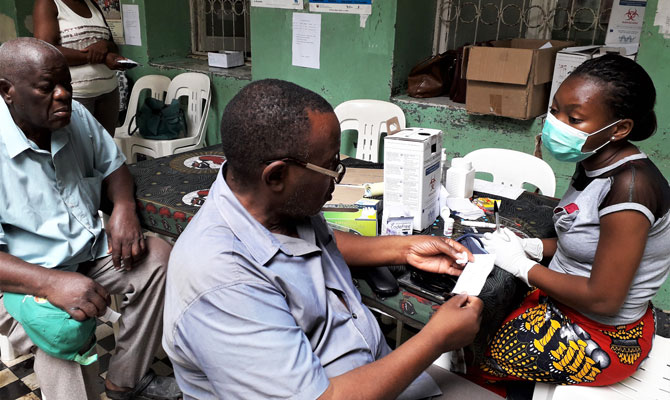Non-communicable diseases (NCDs), in particular diabetes mellitus, cardiovascular diseases, asthma and cancer, constitute a priority for the Government of Mozambique and an integrated approach has been developed in order to tackle this type of diseases. Within the already existing National Health Services – in close partnership with the Ministry of Health – two programs managed by Doctors with Africa CUAMM have been designed and implemented.
The first program, “Integrated primary health care for diabetes and hypertension”(WDF12-745) financed by World Diabetes Foundation – WDF, aims at strengthening diabetes and hypertension care at primary level, raising awareness, and improving health information management in 3 Provinces in Mozambique: Maputo, Sofala and Cabo Delgado. The program focuses on Health Units with the objective of establishing appropriate consultation for diabetes and arterial hypertension in27 Districts, covering81 Health Units at the end of the third year of project implementation. Activities of the project involve capacity building based on training of physicians, nurses and community health workers, with the provision of basic equipment in the Heath Centers and the improvement of the information system for patients with chronic diseases.
The second and complementary program, “NCDs Capacity Project: Support to the fight against Non-Communicable diseases in Mozambique” financed by the Italian Development Cooperation Agency, it focuses on policy development, patient flow and management implementation, and operational research. It covers 4 Provinces (Maputo, Sofala, Zambezia and Nampula) reaching the secondary and tertiary levels of care.The initiative supports specifically the National Authorities in the adjustment of local policies and programs for the prevention, screening, treatment and follow up of chronic diseases with the creation of an appropriate and standardized model of care, integrated into the local health system. In addition, it improves the availability of data systems that are useful for the management of the interventions against NCDs, through the strengthening of epidemiological surveillance sites and operational research. The program involves the Central Hospital of Maputo, the Central Hospital of Beira in Sofala Province, the Central Hospital of Quelimane in Zambezia Province and the Central Hospital of Nampula. The four Hospitals represent the reference structures for a total amount of 2.604.105 people.
In the Provinces where both programs are implemented in synergy, benefits increase exponentially. On one side, prevention and screening increase at district and community level; on the other side, an efficient reference system is created at hospital level. In other words, the reference system is prepared by one program to address the demand of patients that is createdby the other programthrough sensitization campaigns. Awareness raising campaigns have already started, reaching regularly every citizen by SMS.
The Mozambican Diabetes Association AMODIA, is a close partner of the initiative and it represents the source for awareness activities, the development of training material and it is involved in the operational research. Moreover, AMODIA, based only in Maputo in this pilot phase, will represent a pole of excellence able to perform even second level analyses (such as albuminuria presence and funds) and to guarantee a complete approach in terms of coverage and quality, similar to international standards. The Mozambican Ministry of Health has the overall responsibility in relation to implementation of both programs, included the provision of structures, staff and facilities. This visibly assures the sustainability of the initiatives and the achievement of the objectives. The burden of diabetes and other chronic diseases in developing countries is growing and there is need to scale up existing and innovative partnership models and financing streams. Even small “seed programs” can be catalysts for bilateral funding at a larger scale. Combining and integrating programs is one possible innovative way to address an existing crucial challenge and scale up results and effectiveness. Indeed, the synergy between these two programs, not only ensures a multi-level coverage addressing non-communicable diseases but also an extended geographical coverage in the Country.




